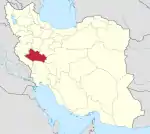Lorestan province | |
|---|---|
| Persian: استان لرستان | |
 Location of Lorestan province in Iran | |
| Coordinates: 33°29′14″N 48°21′14″E / 33.4871°N 48.3538°E | |
| Country | Iran |
| Region | Region 4 |
| Capital | Khorramabad |
| Counties | 11 |
| Government | |
| • Governor-general | Farhad Zivyar |
| • MPs of Assembly of Experts | Ahmad Moballeghi and Hashem Niazi |
| • Representative of the Supreme Leader | Seyyed Ahmad Reza Shahrokhi |
| Area | |
| • Total | 28,294 km2 (10,924 sq mi) |
| Population (2016)[1] | |
| • Total | 1,760,649 |
| • Density | 62/km2 (160/sq mi) |
| Demonym | لرستانی (Lorestani) |
| Time zone | UTC+03:30 (IRST) |
| Main language(s) | Luri, Laki (Kurdish) |
| HDI (2017) | 0.779[2] high · 19th |
Lorestan province (also written Luristan,[3] Lurestan,[3] or Loristan,[3] Persian: استان لرستان, romanized: Ostān-e Lorestān[4]) is one of the 31 provinces of Iran. It is in the western part of the country in the Zagros Mountains and covers an area of 28,392 km2. Its capital is the city of Khorramabad. At the time of the National Census in 2006, the province had a population of 1,689,650 in 382,805 households.[5] The 2011 national census counted 1,754,243 residents in 462,260 households.[6] In 2014 it was placed in Region 4.[7] At the most recent census in 2016, the population of Lorestan province had risen to 1,760,649 inhabitants in 509,025 households.[1]
Etymology
History

_Bronze_Beaker_Luristan_1000_BC_(Rietberg_museum).JPG.webp)
The ancient history of Lorestan is closely intertwined with the rest of the Ancient Near East. In the 3rd and 4th millennium BC, migrant tribes settled down in the mountainous area of the Zagros Mountains. The Kassites, an ancient people who spoke neither an Indo-European nor a Semitic language, originated in Lorestān. They would control Babylonia after the fall of the Old Babylonian Empire ca. 1531 BC and until ca. 1155 BC.
Parts of Luristan were invaded and settled by the Iranian Medes in the 2nd millennium BC. The Medes absorbed the indigenous inhabitants of the region, primarily the Kassites as well as the Gutians, by the time the area was conquered by the Persians in the 1st millennium BC. In February 2017, archeological discoveries related to the Achaemenid era were made in Lorestan for the first time.[9]
Luristan bronze


Small Luristan bronze artworks, usually dated about 1000 to 650 BC, reached the outside world from the late 1920s and are found in museums all over the world, where they are valued for their vigorous style, with many representations of animals. But actually, the beginning of this bronze-making tradition goes back to the mid–3rd millennium BC.
Archaeologists characterized these techniques by the metallurgical analysis of different artifacts,
We have characterized these practices by the compositional and metallurgical analysis of grave goods from several cemeteries in the region including six dating to different phases of the Bronze Age (Early Dynastic I to Ur ED III, circa 2900–2000 BC)—Kalleh Nisar, Bani Surmah, Chigha Sabz, Kamtarlan, Sardant, and Gulal-i Galbi—and four dating to different phases of the Iron Age (circa 1300 B.C.–600 B.C.)—Bard-i Bal, Kutul-i Gulgul, Sar Kabud, and War Kabud.[10]
Technically, the term 'Luristan bronze' usually refers only to the later bronze objects, although they have many similarities. The earlier bronze objects were made during the Elam period.
Lorestan was successfully integrated into the Achaemenid, Parthian and Sasanian empires. Parts of the region managed to stay independent during the Arab, Seljuk and Mongol invasions.
Kurdish rule (959-1597)
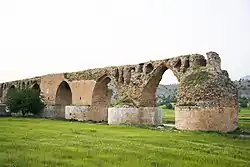
Zand era (1751-1794)
Qajar era (1794-1925)
Agha Mohammad Khan Qajar of the Qajar dynasty was an ardent antagonist of the people of Lorestan and the dynasty applied a policy of divide and rule (nefāq afkanī) for the region where they would pit tribes against each other. When Agha Mohammad Khan took over Iran by defeating the Zand dynasty, he instated non-local governor-generals, princes and other personalities who were never native to Lorestan. Moreover, the governor-generals of Lorestan never had sufficient armed forces to their disposal to maintain order and collect taxes.[11]
The Qajar dynasty would ultimately have a devastating impact on Lorestan including on its territorial integrity, economic decline, political instability, reduction of settled communities and increased pastoral nomadism.[12] Pastoral nomadism increased because the Qajars were unable to maintain law and order, which in turn strengthened tribal autonomy and tribal self-determination, while it meant that the settled population had to protect their lives and property themselves. During this period, the nomadic pastoralist tribes would take over crown land and lands owned by urbanists, pushing the settled rural population who had no control over their properties or farm products to either join the pastoral nomads or leave their villages. The Khorrambad plains were taken by the Baharvand tribe.[13]
Visiting the region in 1917, Cecil J. Edmonds noted that Khorramabad was the only city in the province and that all villages had been ruined or deserted. When Rawlinson had visited the area in 1836, he contrarily noted: "After breakfast I rode into Khorramabad, a distance of 5 miles from the foot of the hills, through a richly cultivated district thronged with villages and garden".[14]
Pahlavi Iran (1920s-1979)
Conquest of Lorestan
The establishment of Pahlavi Iran by Reza Shah in the 1920s demanded a change in the traditional relationship between the state and the locals. This demand for change resulted in a war in the spring of 1922 and subsequently the subjugation of the locals.[15] While having support among the urban population along with the leaders of the Sagvand and Baharvand tribes, many tribal leaders were skeptical of a returning state power to Lorestan.
In a statement to the tribesmen in Lorestan in 1924, the Shah stated that he equated nomadic pastoralism to savagery and the tribal way of life as an obstacle to modernization and progress. Conquering the anarchic Lorestan was important to the Shah economically, politically, militarily and symbolically and is also paved the way for the state to conquer Khuzestan. No reliable sources exist on the capture of Lorestan and no mention of the atrocities against the local population nor the assistance of some tribes for the Shah.[16]
The Laki-speaking Beiranvand was the most troublesome tribe for the state and confrontations between the tribe and state took place in the Silakhor Plain near Borujerd in late spring of 1922. Other tribes did not confront the Pahlavi forces due to disunity, while the governor of Lorestan believed it was inappropriate for him to confront the Shah because he was a state representative. Nevertheless, he did not support Shah rule over Lorestan who he considered a debased Cossack.[17]
In December 1923, the small army of the Shah (around 2,500 men) advanced toward Khorramabad but its first column was fully wiped out by the Beirvanvand tribe and their arms and ammunition was looted. The second column succeeded in breaking the siege on Khorramabad and was welcomed by the local population as the tribes were at their winter territories faraway from the city. The new state would appoint local people as officials including the most powerful man in Lorestan who was appointed governor of Tarhan District and Shir Mohammad Khan of the Sagvand tribe was asked to be advisor for the governor and the army.
The Baharvand leaders worked hard to prevent any confrontation between the army and the tribes but General Ahmadi went ahead with executions resulting in bloodshed and a continuation of hostilities. Both leaders from the rebellious Beiranvand and tribal leaders who had supported the Shah against the Beiranvand were executed. The Beiranvand tribe would consequently rebel again while other tribes avoided continued confrontation despite being distrustful to the new state. Other tribes who did rebel were the Kurdish Chegini tribe and the Romani.[18] They were successful as they fought, defeated and looted the army.
The news angered General Shah Bakhti who chose to send his own force to the region, but his men never reached Khorramabad as the Chegini caught and beat him, and moreover killed around 120 of his men.[19] The defeat and humiliation of the army reached the Beiranvands who then urged for a unified tribal attack against the army and received support from the Papi, Baharvand, Chegini tribes and half of the Judaki tribe.
These tribes collectively attacked Khorramabad in late May 1924 and drove the army into the fortresses in the city as they suffered large casualties again with ammunitions taken by the tribes. The tribes then sieged the city for 38 days which forced General Shah Bakhti to retreat to Borujerd with the blessing of the Shah. However, the leader of the Sagvands persuaded the General to not retreat as the army would be wiped out and noted that the tribes could not fight for a long time because of the shortage of ammunition and lack of provisions. During this period, the army received endless support from the population of Khorramabad.
By June 1924, General Ahmadi was dispatched with his army to Khorramabad and began fighting the tribes but with no results. During the siege, consultations were taking place between tribe and the state to end the conflict and the Baharvand tribe was the first tribe to withdraw from the tribal alliance due to a dispute over captured cannon and other matters. The Judaki, Papi and Chegini would follow suit forcing the Beiranvand tribe to withdraw as well. The subsequent conquest of Lorestan is attributed to the alliance of the Shah with some dedicated tribes. Reza Shah visited Lorestan in the summer of 1924 as he was planning on attacking Khuzestan and some tribes including the Sagvand would enter Dezful with the army without any incident.[20]
Historical maps
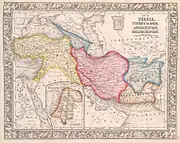 Luristan in 1863, c1860.
Luristan in 1863, c1860.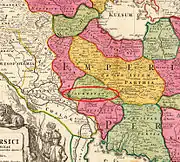 Luristan in 1720.
Luristan in 1720._in_1780-90.jpg.webp) Luristan in 1780-90.
Luristan in 1780-90._in_1831.jpg.webp) Luristan in 1831.
Luristan in 1831.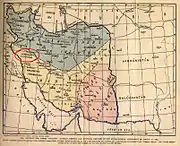 Luristan in The Russo-British Pact in 1907.
Luristan in The Russo-British Pact in 1907.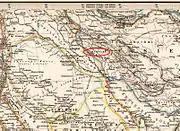 Luristan in 1875.
Luristan in 1875.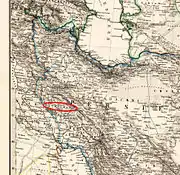 Luristan 1875.
Luristan 1875._in_1706-08.jpg.webp) Luristan in 1706-08.
Luristan in 1706-08.
Geography
In the wider sense it consists of that part of western Iran coinciding with the Ilam province and extending for about 650 km on a northwest to southeast axis from Kermanshah to Fars, with a breadth of 150–180 km. The terrain consists chiefly of mountains, with numerous ranges, part of the Zagros chain, running northwest to southeast. The central range has many summits that almost reach the line of perpetual snow, rising to 4000 m and more. It feeds the headwaters of Iran's most important rivers, such as the Zayanderud, Jarahi, Karun, Diz, Abi, Karkheh. Between the higher ranges lie many fertile plains and low hilly, well-watered districts.
The highest point of the province is the Oshtorankuh peak at 4,050 m. The low-lying areas being in the southernmost sector of the province are approximately 500 m above sea level. Oak forest covers the outer slopes, together with elm, maple, walnut, and almond trees.[21]
Western Luristan comprises a series of parallel fertile valleys running high in the Zagros mountains. The Pusht-i Kuh region is in the western foothills of the Kabir Kuh range. The Pish-i Kuh region lies to the east of Kabir Kuh. This area had human settlements during the Bronze Age as early as the mid–3rd millennium B.C.
Climate
Climatically, the province can be divided into three parts. The mountainous regions, such as Borujerd, Dorud, Azna, Nurabad, and Aleshtar, experience cold winters and moderate summers. In the central region, the spring season begins in mid-February and lasts till mid-May. The city of Khorramabad is in this realm. However, southern areas such as Pol-e-Dokhtar and Papi, are under the influence of the warm air currents of Khuzestan, and have hot summers and relatively moderate winters.[22]
Administrative divisions

| Administrative Divisions | 2006[5] | 2011[6] | 2016[1] |
|---|---|---|---|
| Aligudarz County | 134,802 | 140,275 | 137,534 |
| Azna County | 70,462 | 71,586 | 74,936 |
| Borujerd County | 320,547 | 337,631 | 326,452 |
| Delfan County | 137,385 | 144,161 | 143,973 |
| Dorud County | 159,026 | 162,800 | 174,508 |
| Dowreh County1 | — | 43,221 | 41,756 |
| Khorramabad County | 509,251 | 487,167 | 506,471 |
| Kuhdasht County | 209,821 | 218,921 | 166,658 |
| Pol-e Dokhtar County | 74,537 | 75,327 | 73,744 |
| Rumeshkan County2 | — | — | 39,058 |
| Selseleh County | 73,819 | 73,154 | 75,559 |
| Total | 1,689,650 | 1,754,243 | 1,760,649 |
| 1Separated from Khorramabad County 2Separated from Kuhdasht County | |||
Cities
According to the 2016 census, 1,134,908 people (over 64% of the population of Lorestan province) live in the following cities: Aleshtar 33,558, Aligudarz 89,268, Azna 47,489, Bayranshahr 1,720, Borujerd 234,997, Chalanchulan 2,223, Chaqabol 6,125, Darb-e Gonbad 2,131, Dorud 121,638, Firuzabad 3,399, Garab 3,295, Haft Cheshmeh 870, Khorramabad 373,416, Kuhdasht 89,091, Kunani 7,768, Mamulan 7,656, Momenabad 1,821, Nurabad 65,547, Oshtorinan 5,520, Pol-e Dokhtar 26,352, Sarab-e Dowreh 1,713, Sepiddasht 2,917, Shulehabad 1,531, Veysian 2,087, and Zagheh 2,776.[1]
Demographics
Lurs
Lorestan province is one of the main settlements of the Lur people and the Northern variety Luri language is the main language of the province.[23] Northern Luri is also spoken in southern Ilam and Khuzestan provinces.[24][25]
Lurs form the majority of the population of Khorramabad, the largest city and the capital of the province, Borujerd and Dorud, the second and the third largest cities of the province respectively.[8] Khorramabad is also the largest Luri-speaking city in Iran and the world.[26][27]
Kurds
The northern part of Lorestan is populated by the Kurds of the Lak tribe who were estimated to constitute over 65% of the population in the province in 1980.[28][29] Laks live in the Delfan, Dowreh and Selseleh counties which are populated by various subtribes including the Chegini, Itivand, Kakavand, Nurali and Papi.[28][30] Oshtorinan District in Borujerd County is moreover populated by the Hasanvand tribe.[31]
Aligudarz County, Azna County, Kuhdasht County, Khorramabad County and Pol-e Dokhtar County are ethnically mixed and populated by both Kurdish and Luri tribes.[32][33][34]
Survey
Linguistic composition of the province in 2023:[35]
Notable people
- Hossein Borujerdi, Iranian Sayyid
- Shahmirza Moradi, musician
- Nasrollah Kasraian, photographer
- Abdolhossein Zarrinkoob, writer, historian, and critic
- Sayyed Jafar Shahidi, writer, historian, and critic
- Parviz Shahbazi, writer and filmmaker
- Loris Tjeknavorian, Armenian-Iranian composer and conductor
- Mehdi Karroubi, politician
- Qadam Kheyr, local heroine
- Narges Rashidi, actress
- Seyyed Ahmad Reza Shahrokhi, representative of Supreme-leader
See also
References
- 1 2 3 4 "Census of the Islamic Republic of Iran, 1395 (2016)". AMAR (in Persian). The Statistical Center of Iran. p. 15. Archived from the original (Excel) on 12 October 2020. Retrieved 19 December 2022.
- ↑ "Sub-national HDI - Area Database - Global Data Lab". hdi.globaldatalab.org. Archived from the original on 2018-09-23. Retrieved 2018-09-13.
- 1 2 3 "Luristan (Lorestan) Province". Iran Visitor. Archived from the original on 23 March 2016. Retrieved 19 March 2016.
- ↑ "استانداری لرستان" (in Persian). Archived from the original on 2020-11-29. Retrieved 2020-12-26.
- 1 2 "Census of the Islamic Republic of Iran, 1385 (2006)". AMAR (in Persian). The Statistical Center of Iran. p. 15. Archived from the original (Excel) on 20 September 2011. Retrieved 25 September 2022.
- 1 2 "Census of the Islamic Republic of Iran, 1390 (2011)" (Excel). Iran Data Portal (in Persian). The Statistical Center of Iran. p. 15. Retrieved 19 December 2022.
- ↑ همشهری آنلاین-استانهای کشور به ۵ منطقه تقسیم شدند [Provinces were divided into 5 regions]. Hamshahri Online (in Persian). 22 June 2014. Archived from the original on 23 June 2014.
- 1 2 "Lorestan Province" (in Persian). Lorestan general office of roads and urban development. Archived from the original on 22 April 2021. Retrieved 22 April 2021.
- ↑ "Archeologist: First signs of Achaemenids discovered in Western Iran". irna.ir. 6 February 2017. Archived from the original on 8 February 2017. Retrieved 28 April 2018.
- ↑ Current Projects in Luristan Archived 2017-02-02 at the Wayback Machine penn.museum
- ↑ Sekandar, Amanolahi (2002). "Reza Shah and the Lurs: The Impact of the Modern State on Luristan". Iran & the Caucasus. Brill Publishers. 6 (1/2): 194–195. JSTOR 4030721. Archived from the original on 2019-08-27. Retrieved 2022-01-05 – via Jstor.
- ↑ Sekandar, Amanolahi (2002). "Reza Shah and the Lurs: The Impact of the Modern State on Luristan". Iran & the Caucasus. Brill Publishers. 6 (1/2): 196. JSTOR 4030721. Archived from the original on 2019-08-27. Retrieved 2022-01-05 – via Jstor.
- ↑ Sekandar, Amanolahi (2002). "Reza Shah and the Lurs: The Impact of the Modern State on Luristan". Iran & the Caucasus. Brill Publishers. 6 (1/2): 199–200. JSTOR 4030721. Archived from the original on 2019-08-27. Retrieved 2022-01-05 – via Jstor.
- ↑ Sekandar, Amanolahi (2002). "Reza Shah and the Lurs: The Impact of the Modern State on Luristan". Iran & the Caucasus. Brill Publishers. 6 (1/2): 200. JSTOR 4030721. Archived from the original on 2019-08-27. Retrieved 2022-01-05 – via Jstor.
- ↑ Sekandar, Amanolahi (2002). "Reza Shah and the Lurs: The Impact of the Modern State on Luristan". Iran & the Caucasus. Brill Publishers. 6 (1/2): 193–218. doi:10.1163/157338402X00124. JSTOR 4030721. Archived from the original on 2019-08-27. Retrieved 2022-01-05 – via Jstor.
- ↑ Sekandar, Amanolahi (2002). "Reza Shah and the Lurs: The Impact of the Modern State on Luristan". Iran & the Caucasus. Brill Publishers. 6 (1/2): 201–203. JSTOR 4030721. Archived from the original on 2019-08-27. Retrieved 2022-01-05 – via Jstor.
- ↑ Sekandar, Amanolahi (2002). "Reza Shah and the Lurs: The Impact of the Modern State on Luristan". Iran & the Caucasus. Brill Publishers. 6 (1/2): 203–204. JSTOR 4030721. Archived from the original on 2019-08-27. Retrieved 2022-01-05 – via Jstor.
- ↑ Sekandar, Amanolahi (2002). "Reza Shah and the Lurs: The Impact of the Modern State on Luristan". Iran & the Caucasus. Brill Publishers. 6 (1/2): 205–206. JSTOR 4030721. Archived from the original on 2019-08-27. Retrieved 2022-01-05 – via Jstor.
- ↑ Sekandar, Amanolahi (2002). "Reza Shah and the Lurs: The Impact of the Modern State on Luristan". Iran & the Caucasus. Brill Publishers. 6 (1/2): 207. JSTOR 4030721. Archived from the original on 2019-08-27. Retrieved 2022-01-05 – via Jstor.
- ↑ Sekandar, Amanolahi (2002). "Reza Shah and the Lurs: The Impact of the Modern State on Luristan". Iran & the Caucasus. Brill Publishers. 6 (1/2): 207–209. JSTOR 4030721. Archived from the original on 2019-08-27. Retrieved 2022-01-05 – via Jstor.
- ↑ "Lorestān | region, Iran | Britannica". Archived from the original on 2014-07-14. Retrieved 2014-07-10. Lorestan region
- ↑ Lorestan Land of Culture and Civilization
- ↑ "Lorestan Province" (in Persian). Lorestan general office of cultural heritage, handicrafts and tourism. Archived from the original on 22 April 2021. Retrieved 22 April 2021.
- ↑ "Luri, Northern". Ethnologue. Archived from the original on 2 March 2021. Retrieved 21 February 2021.
- ↑ Minorsky, M. V. (2012). "Luristān". Encyclopedia of Islam. 2. doi:10.1163/1573-3912_islam_COM_0588. Archived from the original on 2021-09-23. Retrieved 2021-02-20.
- ↑ "Khorramabad is the largest city of Lurs" (in Persian). Yafte news agancy. Archived from the original on 22 April 2021. Retrieved 22 April 2021.
- ↑ "Lorestan Province" (in Persian). Lorestan council of dispute resolution. Retrieved 22 April 2021.
- 1 2 "تغییرات زیستی و اسمی قوم لک". Shahokhabar (in Persian). Archived from the original on 10 October 2020. Retrieved 6 October 2020.
- ↑ Hamzeh’ee, Mohammad Reza (2015). "Lak tribe". Iranica Online. Archived from the original on 10 April 2021. Retrieved 4 April 2021.
- ↑ "آگاهيهائي درباره ايلها و طايفههاي لر خرم آباد" (in Persian). Archived from the original on 30 January 2013. Retrieved 22 December 2020.
- ↑ "سیمای عشایر استان لرستان" (PDF) (in Persian). تهیه وتنظیم : اداره مطالعات وبرنامه ریزی: 3. Archived (PDF) from the original on 20 April 2021. Retrieved 26 April 2020.
{{cite journal}}: Cite journal requires|journal=(help) - ↑ Anonby, Erik John (2003). "Update on Luri: How many languages?". Journal of the Royal Asiatic Society. 13 (2): 171–172. doi:10.1017/S1356186303003067. S2CID 162293895.
- ↑ "معرفی شهر خرم آباد". khoramabad.farhang.gov.ir (in Persian). Archived from the original on 2021-04-20. Retrieved 2020-12-26.
- ↑ "تهیه وتنظیم : اداره مطالعات وبرنامه ریزی" (PDF): 2–3. Archived from the original (PDF) on 28 July 2018.
{{cite journal}}: Cite journal requires|journal=(help) - ↑ "Lorestan Province: Heritage languages". Iran Atlas. Carleton University. 2023. Retrieved 26 October 2023.
Further reading
- W. Barthold (1984). "Luristan and Khuzistan". An Historical Geography of Iran. Translated by Svat Soucek. Princeton University Press. pp. 180–194. ISBN 978-1-4008-5322-9.

